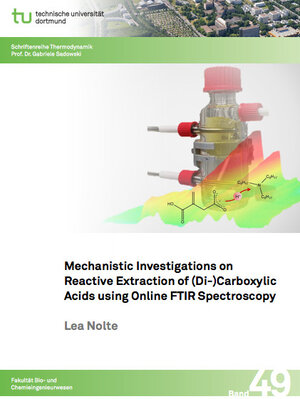
×
![Buchcover ISBN 9783843953672]()
Mechanistic Investigations on Reactive Extraction of (Di-)Carboxylic Acids using Online FTIR Spectroscopy
von Lea NolteThe growing interest in a bio-based industry has increased the demand for biocatalytically produced dicarboxylic acids drastically in recent decades. However, the downstream processing of dicarboxylic acids from biocatalytic origin still is a challenging task. One innovative approach applies an initial reactive extraction (RE) using hydrophobic amine extractants into an organic solvent, followed by a subsequent back-extraction (BE) using water-soluble amine extractants into a (fresh) aqueous solution. Within this work, an experimental setup incorporating Fourier Transform Infrared (FTIR) spectroscopy and an experimental procedure for the systematic investigation on the complex formation between dicarboxylic acids and amine extractants were developed on the example of itaconic acid (IA). Application of online in situ FTIR spectroscopy allowed the direct characterization and quantification of the acid-extractant complex, thereby giving insights into the (1) mechanism (interactions between dicarboxylic acid and amine extractant in the acid-extractant complex), (2) stoichiometry, (3) reaction kinetics and (4) reaction equilibrium of complex formation. The in-depth understanding of RE and BE on a molecular level, gained by the complete characterization of the complex formation, enabled the definition of a guideline for an optimized selection of amine extractants for RE and BE. Applying the novel online FTIR spectroscopy setup allowed to monitor a complete process sequence of RE and BE of IA with selected amine extractants, validating the proposed guidelines for extractant selection. Online monitoring of the extraction processes and the acid-extractant complex further served to elucidate relevant influencing factors on RE and BE. Possibilities for the thermodynamic modeling of the acid-extractant complex applying the perturbed-chain statistical associating fluid theory (PC SAFT) equation of state were evaluated.


